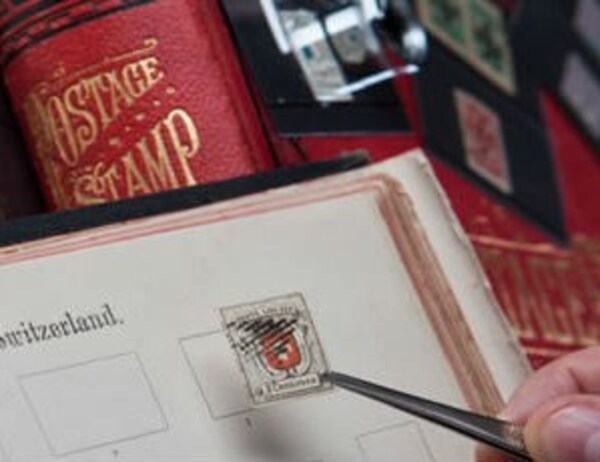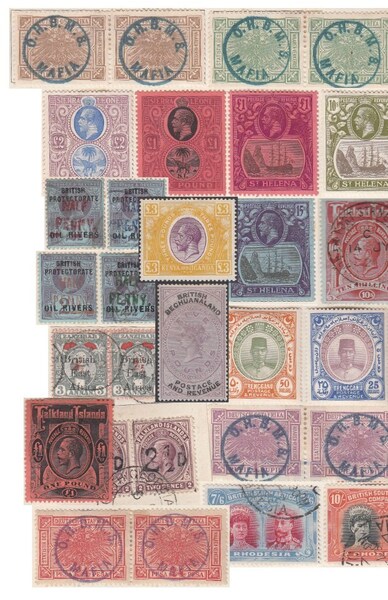The Mount Currie Express One Penny stamp, issued in 1874 by the Ballance and Goodliffe store is one of South Africa's rarest philatelic pieces - almost never being offered for sale. Less than fifty Mount Currie Express stamps exist. The British Museum has a single vertical strip of four stamps from the Tapling collection. (These rare stamps were issued in sheets of twelve - three across and four deep).
One of these rare stamps will feature in our Sandafayre Sale No. 5273 which closes on 21st November 2017.
The Griqua “nation” was born out of inter-racial marriages in South Africa's Cape between the Dutch, Khoikhoi, British, San, Xhosa, Indian, Malaysian, Indonesian and Mozambican peoples over hundreds of years of trade, slavery and colonialism. The mixed race people, known originally as Basters, later Griquas, became increasingly squeezed out from their land by the Boers trekking inland to escape British rule.
In the 1750s they were led by Adam Kok I, who started work as a cook (hence "Kok") and managed to obtain burgher rights and a farm near the present Piketberg. Adam Kok married the daughter of the chief of a Khoikhoi clan, the Chariguriqua, and attracted a mixed following of Basters, Khoikhoi and escaped slaves as he moved to Little Namaqualand. Later his descendents moved into an abandoned area of the Mpondo Kingdom called Nomansland, later renamed Eastern Griqualand where Adam Kok III established a system of government with leaders, kaptyns and magistrates.
East Griqualand in the 1860s was a wild and very isolated region lying east of the great Drakensberg and Basutoland, west of the warring Mpondolisi and their coastal strip while being constantly pressured by the Cape Colony to the south and the Natal Colony to the north.
However in exchange for a settlement of a border conflict between the Afrikaners and the Cape colonists, the British agreed, under a secret agreement, to expel the entire Griqua population. Adam Kok III and his followers not wanting to become either subjects of the Crown in the Cape Colony or servants in the Free State,were forcibly removed into exile in 1863 to the area around Mount Currie and set up a Laager, a simple settlement made up of small huts, where they remained for over half a decade.
This general region in the mid-1800s is generally regarded as the source of the "Kaffir wars" creating tension with the white settlers in the north eastern Cape and an obsession with how to deal with quelling the violence and upheaval by "kaffirs". This unrest was mainly created by the Mpondolisi, the armies under Moshoeshoe in Basutoland as well as a number of disgruntled rebel Griquas (like Smit Pommer) who had made a living from marauding and robbery before travelling from Philippolis and other parts in 1859.
Nearly all business in this part of the country was carried on by barter as there was very little money (notes or coin) in circulation. Wool, livestock, skins, timber, grain and other farm products were exchanged for clothing, groceries and manufactured goods at markets and trading posts.
Goodliffe and Balance were a Natal trading firm who opened 3 stores in 1873, two in the Matatiele District and one at Mount Currie.
Rev W Dower in his book, “The Early Annals of Kokstad” (1902), notes the following on Goodliffe and Ballance,on page 37, “While Goodliffe and Ballance conducted business in the old laager, the Griquas were gradually moving away from it. Their manager, Mr W Darby, was not at all sanguine about the removal taking place. He established a weekly post by Kaffir runner to the nearest post office in Natal. It was a private postal service, but practically became public by having its own postage stamp. This was the first attempt at a regular postal service. If the Griqua Government wished to avail itself of the "Mount Currie Express" it required to procure stamps and use these like anyone else. There are, I am informed by competent authority, four of the Mount Currie Express stamps preserved in the British Museum. If any others exist they would, no doubt, be quoted at a high figure in the market of stamp collectors. A notice of the history of the rare stamp by Mr Darby appeared in the Philatelists Journal but I do not know the date of the issue containing it. The picture of the stamp may be seen in page 15, part 3 of Stanley Gibbons Local Postage Stamps of the World, 1899, and an illustration will be found in another page”.
Much sooner than expected the Laager became deserted and trade dwindled for Messrs Ballance and Goodliffe. As the business left them the store tumbled down. The doors and windows, fittings and timber were bought up by the Rev. Mr Kirby and used in the erection of a turf house opposite the Congregational Manse in Kokstad.
(With acknowledgement to the research of the late Tom Mullins)


 General
General
 General
General
 General
General